Royal Victoria Hotel
Houses within 10km of this house
Displaying 55 houses.
Houses within 10km of Royal Victoria Hotel
Displaying 55 houses.
| House name | Description | |
|---|---|---|
| Cahernane | Cahernane House was the property of Rev. Richard Herbert at the time of Griffith’s Valuation, when it was valued at £22. Lewis mentions it as the seat of H. Herbert in 1837. Bary indicates that this house, originally built in the early 18th century, was replaced in the 1870s when the present building was constructed. The property was sold by the Herbert family at the end of the 19th century and is now a luxury hotel. In the 1940s though, the Irish Tourist Association reported that the gardens were well-maintained by Miss Herbert. See www.cahernane.com. |

|
| Summerhill (Mount Meredith) | In 1786 Wilson refers to Mount Meredith as a gentleman's seat close to Killarney. Bary writes that this is the property that later became known as Summerhill, held by The O’Donoghue. The Ordnance Survey Name Books note that this townland was leased by St. John Mason to Richard McGillycuddy and Madam O'Donoghue in the 1830s. The house is described as "formerly a handsome house but is now suffering to go to ruin". At the time of Griffith’s Valuation it was valued at £3 and leased to James Donovan. A substantial modern farm exists at the site now. | |
| Cleeny | At the time of Griffith’s Valuation, Maurice Brennan was leasing a property at Cleeny, valued at almost £7, from The O’Donoghue estate. In 1906 it was owned by Lord Kenmare's estate and valued at £5 15s. Modern farm buildings are located at the site. | |
| Coolgarriv House | James Donovan, MD, was leasing Coolgarriv House from The McGillycuddy’s estate at the time of Griffith’s Valuation, when it was valued at £12 10s. Bary, quoting the Ordnance Survey Name Books, states that Coolgarriv House was built by the Eager family in the 1830s at a cost of £900. It is still extant and occupied. | |
| Curragh House | Lady Headley’s estate was leasing a property valued at £6 5s to James Beazly at the time of Griffith’s Valuation. Bary states that the Beazlys acted as agents for the Headley estate and that Curragh House was built c.1810. The house underwent renovation in the later twentieth century. | |
| Aghadoe House | Lady Headley was in possession of Aghadoe House at the time of Griffith’s Valuation when it was valued at £53. It is mentioned as " a very fine building, densely shaded with trees" in the Ordnance Survey Name Books of the 1830s. Bary, quoting the Name Books, states that it was built in 1828 at a cost of £12,000 though the National Inventory of Architectural Heritage states that it was probably redesigned in the 1860s. It was the seat of Lord Headley in 1894. The house was burnt in 1922 but re-built to the same plan. The Irish Tourist Association survey noted in 1943 that it was then the property of Robin Hilliard and was being extensively renovated. It is now the Killarney International Youth Hostel. |
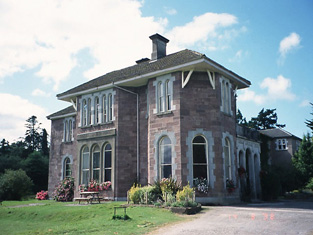
|
| Aghadoe Cottage | Archdeacon Forester was leasing Aghadoe Cottage from the Headley estate at the time of Griffith’s Valuation when it was valued at £7 10s. Bary states that it was built by the Archdeacon in 1838 though the Ordnance Survey Name Books mention him as being in residence there before that. It is still extant and is now run as Killeen House Hotel. See www.killeenhousehotel.com |
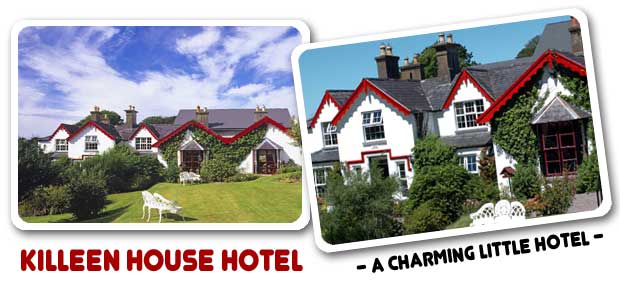
|
| Gortroe Lodge | At the time of Griffith’s Valuation, Gortroe Lodge was being leased by John Morrogh Bernard from John C.O’Riordan when it was valued at £22. Lewis records Gortroe Lodge as the seat of S. Riordan. Bary states that, according to John O’Donovan, Stephen Riordan built Gortroe Lodge in 1831. The house is now demolished and much development has taken place in the area. | |
| Muckross House (Muckross Abbey) | McCoole states that the Herberts had a house on the Muckross peninsula since at least the early 18th century, on lands leased from the MacCarthaigh Mor family. A new house was constructed in the 1770s. In 1837 Lewis described Muckross as "situated in a demesne of enchanting beauty". The present Muckross House, was built between 1839-43. At the time of Griffith’s valuation it was valued at £129. It continued to be owned by the Herbert family until the 1890s, when, the family fortunes having declined, it was sold by the Standard Life Assurance Company, and purchased by Lord Ardilaun. He was the owner in 1906 when it was valued at £130. In 1910 it was sold to an American family, Bowers Bourn who in turn gave it to their daughter and son-in-law, Maud and Arthur Vincent. It was presented to the nation in 1932 and now forms the centre of the Killarney National Park. |

|
| Grenagh House | Denis Lawlor was leasing Grenagh House from Henry Herbert’s estate at the time of Griffith’s Valuation when it was valued at £23 15s. Lewis mentions Grena as the seat of John O’Connell in 1837. The Ordnance Survey Name Books indicate that it was built by Mrs. Delaney in 1792. Bary states that O’Connell was obliged to leave the house due to debts. It then came into the possession of Denis Shine Lawlor and later again, Daniel James. It was afterwards the property of the O'Connor family but has been ruinous since the mid twentieth century. | |
| Muckross Hotel | William Roche was leasing a property valued at £30 from the Herbert estate at the time of Griffith’s Valuation. The building marked as hotel on the 1st edition 6” map is recorded on the 1894 map as Muckross Hotel. Roche was leasing an adjoining building, valued at £13, from Daniel Clifford in the same vicinity. Horgan states that the Tourist’s Illustrated Handbook for Ireland, 1853, refers to Mr. Roche as manager of the Muckross Hotel. The property is still a hotel, now known as the Muckross Park Hotel. Daniel O’Sullivan was leasing a property in the same area from the Herbert estate, valued at £12 12s. In 1906 Lord Ardilaun owned the property at Dromyrourk valued at £20. |

|
| Torc Cottage | At the time of Griffith’s Valuation, Henry Herbert was leasing a property at Torc, valued at £39, to Sir Thomas Herbert. Lewis refers to it as the residence of Capt. Herbert in 1837 while Leet mentions it as the seat of Charles Herbert in 1814. In 1906 it was part of the Guinness estate and valued at £11 10s. Bary states that Torc Cottage was a handsome property surrounded by plantations. McCoole claims that Henry Arthur Herbert had built Torc Cottage for his mistress. The building is no longer extant. | |
| Caherdean House | Charles Daly was leasing Caherdean House from Henry Herbert at the time of Griffith’s Valuation, when it was valued at £11 10s. Bary suggests that the Lawlors may have had connections with Caherdean House around 1800 but later in the 19th century the Herberts were the landlords. The house is still extant and part of a large farm. . |

|
| Castle Lough | Martin Lawlor was leasing a property valued at £55 to Thomas Cotter at the time of Griffith’s Valuation. It is described by Lewis as the seat of D.S. Lawlor in 1837. Bary states that there was an earlier house, belonging to the Madden family, at this site. In the later 19th century, Thomas Cotter ran the property as an hotel. It has been incorporated into the Lake Hotel complex. See www.lakehotel.com. |
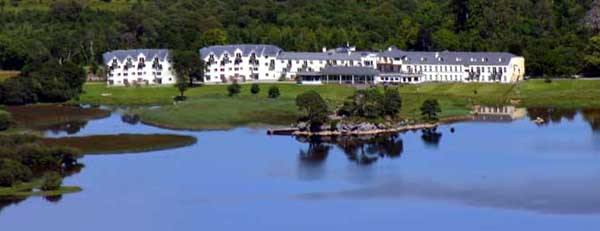
|
| Ardagh | Martin Lawlor was in possession of a property valued at £11 5s at Ardagh, at the time of Griffith’s Valuation. There is no house marked on the 1st edition OS map, the Lakeview Hotel appears to have occupied the site in 1895. | |
| Killarney Mills | Christopher Gallway was leasing an extensive milling concern from the Kenmare estate at the time of Griffith’s Valuation. It was then valued at £85. Lewis refers to "the extensive flour-mills of Messers Galway and Leahy, worked by the river Dinagh" in 1837. Lyons notes that the mill complex was sold in the Encumbered Estates Court in 1855 and purchased by Richard Leahy for £1500. It was taken over by the Electricity Supply Board in 1940. The mills are no longer extant. |

|
| Torc View (Torc View Hotel) | Jeremiah Hurley was leasing a hotel valued at £40 from the Gallway estate at the time of Griffith’s Valuation. This was the Torc View Hotel. Horgan states that the building was later purchased by the Loretto Sisters and opened as a boarding school. It is labelled Loretto Convent on the 25-inch map of the 1890s. The site is now occupied by town houses. | |
| Lakeview | At the time of Griffith’s Valuation, James O’Connell was leasing the property from the Herbert estate when it was valued at £13. Lewis calls the house Lakeville in 1837. Leet also mentions a house called Lakeville in 1814 which he refers to as the residence of Francis Russell. Bary states that the existing house was built by James O’Connell in 1870 after he was made a Baronet but that there was an earlier house here also. The latter is mentioned as the residence of Mr. O'Connell in the Ordnance Survey Name Books of the 1830s. It was built in 1740 and located in the southern end of the townland. In 1894 Slater refers to Lakeview as the residence of Sir Maurice J. O'Connell. The house is still extant. |

|
| Ballydowny | Bary states that "Ballydowney is a very old house, probably built in the early 18th century. It was the house in which Robert Emmet, the patriot hanged in Dublin in 1803, was born. His mother was Elizabeth Mason". The Ordnance Survey Name Books record that the proprietor, St. John Mason, had leased the townland to Richard McGillycuddy in the 1830s. By the time of Griffith’s Valuation, the house was valued at £4 and being leased by Charles Daly from Daniel Cronin. In the early 1940s, the Irish Tourist Association Survey also refers to the possible association with Robert Emmet though it indicates that this story may refer to an earlier house, "replaced by the present one, built about a hundred years ago". In 1942 it was occupied by a Mr. Blanchfield and is still extant. | |
| Ballycasheen House | Henry Curtayne was leasing a property in the townland of Ballycasheen from Lord Kenmare’s estate at the time of Griffith’s Valuation, when it was valued at £18. Nearby in the same townland he also held Courteene Hall, which was vacant at the time and was valued at £10 10s. Leet records him as resident at Ballycasheen in 1814. Lewis referred to the residence of the Curtayne family as Courtayne Castle in 1837. The site of Ballycasheen House is now occupied by commercial buildings while The Heights hotel occupies the site of Courteene Hall. | |
| Belview House | Arthur Mahony was leasing a property valued at almost £4 from the Kenmare estate at the time of Griffith’s Valuation. In 1906 it was part of the Kenmare estate and valued at £5 5s. Bary states that this house, very close to the lake shore, was built by James Mahony, of the Dunloe Castle family, in the latter half of the 18th century. In the 1930s, it was still part of the Kenmare estate and Lord Castlerosse supervised the building of Killarney Golf Club here. The original house was demolished to make room for a new clubhouse. | |
| Dooneen Cottage (Upper Park Cottage) | This property on the Earl of Kenmare’s estate was valued at £7 10s at the time of Griffith’s Valuation. In 1786 Wilson refers to Dooneen as the seat of Rev. Dr. Bland. Bary states that it had been built in the 18th century and was one of the chief farm properties on the estate. It is labelled Upper Park Cottage on the 25-inch Ordnance Survey map of the 1890s. Part of the original building appears to be still extant. In the same townland is Wood Park Cottage [V985934], also a farm on the Earl of Kenmare’s estate. It is still extant. | |
| Drom Hall & Sunday's Well | The Kenmare estate held a property valued at £9 in Dromhale townland at the time of Griffith’s Valuation. Bary states that this house was sometimes lived in by an estate agent. It is no longer extant. The nearby property of Sunday’s Well seems also to have been part of the Kenmare estate although at the time of Griffith’s Valuation it was being leased by Walter Murphy, MD to Joseph Fishbourne and was valued at £13. It is no longer extant and this area has been extensively built on. | |
| Dromadeesirt Cottage | Catherine Thompson was leasing a property valued at £5 from the Earl of Kenmare’s estate at the time of Griffith’s valuation. Bary states that this family may have been agents for Lord Kenmare and that local tradition suggests Mr. Thompson was killed by being gored by his bull. The property was occupied until the late twentieth century and farm buildings are still extant at the site. | |
| Fortwilliam House | Named as Lissyviggeen on the 1st edition OS map but as Fort William House on the map of 1896. At the time of Griffith’s Valuation, John Dumas was leasing this property from the Kenmare estate, when it was valued at £11. Bary states that the O’Keeffe family purchased the property in the 1880s. It was still extant and occupied in 1994. | |
| Glena Cottage | At the time of Griffith’s Valuation, the Kenmare estate held properties described as cottages, valued at £16. Horgan indicates that these cottages were built on the estate to cater for tourist visitors. Lewis, in 1837, mentions the elegant cottage of Lady Kenmare, at a short distance from which a banqueting house had been erected by Lord Kenmare for the entertainment of visitors. In 1906 the property at Glena was valued at £16 15s. Bary states that Glena Cottage was burnt in 1922. |

|
| Kenmare House (Killarney House 1) | The original house used by the Browne family, Lords Kenmare, was located in the Demesne. It is named Kenmare House on the 1st edition OS map and by Lewis in 1837 but later came to be called Killarney House. At the time of Griffith’s Valuation, the property was valued at £90. Bary states that this house was probably constructed in the early 18th century. In 1872 the 4th Earl decided to build a new house and the original house was demolished. The later Killarney House was located in Knockreer townland. | |
| Killarney House | The 4th Earl of Kenmare had a new house built in the townland of Knockreer in the 1870s which became known as Killarney House. Bary states that this house was accidentally burnt down in 1913 and never rebuilt. The stable block was later converted into a dwelling and still survives. The last owners, the McShain family, left the property to the nation in the 1960s. An earlier house in this townland, built in 1828,, named in the Ordnance Survey Name Books as Prospect House, was occupied by Thomas Brown in the 1830s. |

|
| Killeen House | Denis Leary was leasing a house valued at £7 10s from the Earl of Kenmare’s estate at the time of Griffith’s Valuation. A farm is still extant at this site. | |
| Mount Prospect | Walter Murphy, MD, is noted as the lessor of a property at Ballynamaunagh, Kilcummin at the time of Griffith’s Valuation when it was valued at £16. The townland was part of Lord Kenmare’s estate. Bary states that the house may have built by the Murphy family in the late 18th century. No trace exists of it in the area now. | |
| Ross Cottage | The Earl of Kenmare’s estate included a forester’s house on Ross Island, marked on the 1st edition OS map as Ross Cottage. At the time of Griffith’s Valuation it was valued at £7 5s. In 1906 it was still part of the Kenmare estate and with the same valuation. The building is now in ruins. | |
| Sheheree Cottage | Captain Denis Curtayne was leasing a property from Lord Kenmare’s estate at the time of Griffith’s Valuation, when it was valued at £17 5s. In 1885 Walford mentions Edward Morrogh Bernard "of Sheheree". Bary also states that the property was later associated with the Morrogh Bernard family. In 1994 it was still extant and occupied. | |
| Woodford House | At the time of Griffith’s Valuation, Mary Curtayne was leasing this property at Lissyviggeen from Lord Kenmare’s estate, when it was valued at £13 5s. Bary states that it was occupied by the Misses Curtayne in the 19th century and is still extant and occupied. | |
| Woodlawn (Killarney) | Francis Bland was leasing Woodlawn House from William Fagan, of Cork, at the time of Griffith’s Valuation, when it was valued at £30. Lewis notes it as the seat of Hon. W. Browne in 1837. Bary states that it was built by William Browne around 1800 but was later lived in by Mahonys, Blands and in the latter part of the 19th century by the Godfrey family. It is no longer extant and the area is now a housing estate. | |
| Churchtown | At the time of Griffith’s Valuation, Sir A. Blennerhassett was leasing Churchtown House to Robert Stokes. In 1837 Lewis refers to it as the seat of Sir A. Blennerhassett. Leet mentions it as the residence of R.A. Blennerhassett in 1814. The house was valued at £31. Churchtown House is still extant. Much of the demesne is now part of Beaufort Golf Course. |
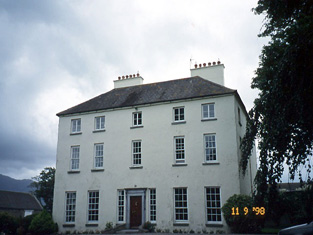
|
| Coolclogher or South Hill | Rev. Richard Herbert was leasing a property valued at £21 to John Leahy at the time of Griffith’s Valuation. He was also leasing a mill, valued at £90 to Richard and John Leahy in the same townland. Lewis records South Hill as the seat of J. Leahy in 1837. Bary states that the house was probably built in the earlier 18th century though it may have been renovated in 1810, probably by the Leahys, in whose family it remained until the end of the 19th century. The Irish Tourist Association survey in the early 1940s reported that it was the private residence of Mr.R. Hilliard. It is now a luxury guest house. See www.coolclogherhouse.com. |

|
| Flesk Lodge | At the time of Griffith’s Valuation, Rev. Richard Herbert was leasing a property to Rev. Robert Hewson when it was valued at £6 10s. Bary states that the latter is recorded as having died at Flesk Lodge in 1880. Since 1957 the site has been occupied by the Gleneagle hotel. | |
| Flesk Cottage | At the time of Griffith’s valuation, this house is recorded as part of the Herbert estate but was unoccupied. It was valued at £24 at the time. Lewis records it as the seat of Capain Godfrey in 1837. The Ordnance Survey Name Books record it as the residence of Arthur Saunders c.1840. Bary states that this house was frequently occupied by the Godfrey family. The ruins are close to the Gleneagles hotel. | |
| Bridgeview | Sir T. Herbert was leasing a property to Capt. W. Dalton at the time of Griffith’s valuation, when it was valued at £17. Bary states that this house was also occupied by the Misses Herbert and by Lady Godfrey at different times in the 19th century. It is no longer extant and modern houses have been built on the site. | |
| Beaufort | Reverend Edward Day was in possession of the house at Beaufort at the time of Griffith’s Valuation when it was valued at £37. Lewis refers to it as the seat of Frederick W. Mullins in 1837. In 1814 Leet also refers to it as the residence of Reverend F. Mullins. In 1786 Wilson refers to Beaufort as the seat of Hon. Dean Crosbie. Various sources, including Bary, indicate that it was built on the site of a tower house known as Short Castle. . It was sold by the Mullins estate in the mid nineteenth century to the Day family who sold it again in the 1880s. Referred to by Slater in 1894 as the seat of Lt-Col. E. Nash Leahy. It is still extant and occupied. |

|
| Cullenagh House | At the time of Griffith’s Valuation, Cullenagh House was occupied by Kean Mahony when it was valued at £22. Lewis records it as the seat of Kean Mahony in 1837 as does Leet in 1814. In 1906 it was the property of Thomas McDonagh Mahony and valued at £18. Bary states that this house was probably built by the Mahonys towards the end of the 18th century. It was still extant but uninhabited towards the end of the twentieth century. | |
| Cullenagh Lower | Myles Mahony was occupying a house at Cullenagh Lwr at the time of Griffith’s Valuation. It was valued at £6 and part of a holding of 176 acres. The house is not shown on thre 25-inch Ordnance Survey map of the 1890s. | |
| Dunloe Castle | At the time of Griffith's Valuation, Daniel Mahony was leasing Dunloe Castle from Thomas H. Broderick when it was valued at £15. Lewis describes it as formerly the seat of the O’Sullivan family but in 1837 the residence of D. Mahony. Leet refers to it as the residence of Daniel Mahony in 1814. Wilson, writing in 1786, mentions Dunloe Castle as the seat of Gustavus Crosbie. In 1894 Slater refers to it as the seat of John Mahony. The Irish Tourist Association surveyor notes that this property has associations with the United Irishmen and states that, in the early 1940s, it was owned by Agnes Petitt. Bary states that it remained in the Mahony family until the mid-20th century. The castle itself is now a ruin, located in the grounds of the Dunloe Castle Hotel. | |
| Nunstown | Robert Leeson was leasing a property valued at £5 to Michael Barrett at the time of Griffith’s Valuation. A substantial farm still exists at the site. | |
| Belleville | John Brennan was leasing this property from William Mayberry at the time of Griffith’s Valuation, when it was valued at £14. | |
| Flesk (Glenflesk) Castle | Daniel C. Coltsmann was in possession of Flesk Castle at the time of Griffith’s Valuation when it was valued at £50. Lewis records it as the seat of J. Coltsmann in 1837. Bary states that the house was also known locally as Glenflesk Castle or Coltsmann’s Castle. It was built in the early decades of the 19th century and continued in the Coltsmann family and their descendents until the early 20th century when it was sold to Major John McGillycuddy. In 1943 the Irish Tourist Association survey noted that "its tall fantastic turrets dominate the countryside". It was then in the possession of Anthony McGillycuddy. It had become ruinous by the end of the 20th century although there were some indications that it might be restored. |
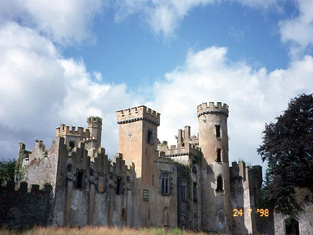
|
| Flesk Priory | The representatives of John Coxon were leasing Flesk Priory to Margaret Newman at the time of Griffith’s Valuation, when it was valued at £26. In 1837 Lewis mentions it as the seat of J.S. Coxon. Bary states that, while O’Donovan claimed it had been built in 1828, it is possible that it was erected in the 18th century. Local tradition maintained that it was to provide accommodation for noble refugees from the French Revolution. It was still extant at the end of the twentieth century. | |
| Roseville Cottage | John Powell was in possession of two properties at Scrahane at the time of Griffith’s Valuation. Roseville Cottage, valued at £8 was vacant while the second property, was leased to Capt. John Kenny. Bary states that the house may have built and used by Lord Kenmare for one of his agents. It was still extant in 1994 but unoccupied and possibly in danger of demolition. | |
| Ballyhar House | In 1786 Wilson refers to Ballyhar, the residence of Mr. Eager. John Leahy was in possession of this property at the time of Griffith's Valuation when it was valued at £17. Bary states that this house was originally built by the Eager family but later sold to the Leahys. It is now a ruin. | |
| Park | Daniel Cronin was occupying the Park property at the time of Griffith’s Valuation, when it was valued at £44. Lewis mentions it as a handsome residence of D. Cronin in 1837. Wilson, writing in 1786, refers to it as the seat of Mr. Cronen. Bary states that it seems to have been originally built in the 18th century but later re-modelled. The Cronins to whom it belonged eventually became Cronin-Coltsmanns on inheriting the Flesk Castle property. It has been extensively altered and run as the Heights Hotel since the mid 20th century. | |
| Tomies | In 1837 Lewis mentions Tomies as the seat of D.J. O'Sullivan. At the time of Griffith's Valuation, the property, valued at £5, was being leased by Daniel O'Sullivan from the Herbert estate. Bary states that this house was more usually associated with the O'Donoghue estate, citing references to "O'Donoghue of Tomies" in the local press. In 1906 Lord Ardilaun owned the property at Tomies East valued at £8 15s. It is now in ruins. | |
| Rockfield | In 1837 Lewis noted that "Rockville" was the property of the representatives of the late John Drew. At the time of Griffith's Valuation, William Whorland was leasing a property valued at £5 10s from the Drew estate. The property was offered for sale by Alicia Wherland in the Landed Estates Court in July 1862 and again in July 1872. In 1906 Rockfield was owned by Bertram Morrogh Bernard and was valued at £11. Bary mentions it as a house associated with the Sealy family. Buildings are still extant at the site. | |
| Danesfort | Captain James Colthurst was leasing this property to Reverend Samuel Butcher at the time of Griffith's Valuation, when it was valued at £11 10. Lewis refers to it as the seat of Captain Colthurst in 1837 "commanding interesting views of the Middle and Lower Lakes". In 1874 the Danesfort estate of Samuel Butcher was offered for sale in the Landed Estates Court. The house is described as "beautifully situated, overlooking the Bay of Castlelough". Bary notes that it was occupied up until the 1920s but is now a ruin. | |
| Fahagh Court | In 1786 Wilson mentions Fagha as the seat of Mr. Falvey. At the time of Griffith's Valuation, Daniel Buckley was leasing this property from John Morrogh Bernard, when it was valued at £3 10s. In 1906 Bertram Morrogh Bernard owned this property, then valued at £25. A house built n the later nineteenth century, it is labelled Fahagh Court on the 25-inch Ordnance Survey map of the 1890s. In 1943 the Irish Tourist Association survey noted that it had been extensively reconstructed and modernised and "bears little resemblance to the historic residence of the Morrogh-Bernards and before them the O'Flavey clan". It was then occupied by the Reynolds family. Bary states that the property became a hotel in the twentieth century before being damaged by fire. The extensive yard complex has now become the Killarney Country Club and holiday accommodation. |

|
| Prospect (Killarney) | In 1786 Wilson that a house named Prospect, one mile from Killarney, was the seat of Mr. Supple. The Ordnance Survey Name Books mention Prospect House as the residence of Thomas Browne in the 1830s. It seems to have become ruinous after this as only a gate lodge is mentioned in Griffith's Valuation and Prospect is now shown on the 25-inch Ordnance Survey map of the 1890s. |

